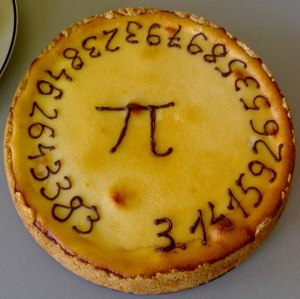Monday is the Day to Celebrate Pi
The enigmatic number Pi (π) can never be calculated, yet it’s essential for everything from keeping satellites in the air to packing beans into cans, not to mention simulating climate, optimizing TV signals, building stadiums, operating smartphones and enabling quantum mechanics.
 At its simplest, Pi is the ratio of a circle’s circumference to its diameter, and it’s exactly the same for circles of any size.
At its simplest, Pi is the ratio of a circle’s circumference to its diameter, and it’s exactly the same for circles of any size.
Monday (the 3rd month, the 14th day and, if we round up, the 16th year of the new century) is Pi Day.
Many students are introduced to Pi in high school and know it as 3.14159, but mathematicians have calculated Pi to more than a trillion digits. Only 39 digits past the decimal are needed to accurately calculate the spherical volume of the universe.
“Pi is an irrational number, you can only ever calculate it approximately,” Curtin University Head of Mathematics Professor Song Wang said in an interview from ScienceNetworkWA.
“It’s really a fascinating number and has attracted many mathematicians over the last 2,000 years,” he says. “Theoretically we can calculate it up to infinite digits, some people have memorized up to 30,000 digits.”
The Guinness World Record for memorizing Pi is 67,890 digits.
“In daily life, you cannot get away from essential geometry, and the only way you can work with geometry is through Pi,” Wang says. “For example, if you’re a cyclist, you can use Pi to work out how far you’ve cycled, or if you’re an engineer, you use Pi in designing car tyres, water flows, buildings...
“For rocket science, you can calculate things like the trajectory of the Earth using Pi.”
Wang works as a numerical analyst, and his own research into Fourier transforms relies heavily on Pi to approximate otherwise-unsolvable equations. Fourier transforms are essential to modern processing of data, including application in 4G networks, Wi-Fi and medical imaging.
Through the Fourier series, Pi appears in the mathematics that describes the circadian rhythms of sleep and wakefulness in people. Pi is intimately associated with waves and the ebb and flow of the ocean’s tides.
Pi is used to calculate the distance between any two given latitude longitude points. As the Earth is a sphere, standard flat-grid calculations cannot be used to determine distance.
Pi appears in both the statement of Heisenberg’s uncertainty principle and the Schrödinger wave equation, which capture the fundamental behavior of atoms and subatomic particles. In the domain of cosmology, π appears in Einstein's field equation, a fundamental formula which forms the basis of the general theory of relativity and describes the fundamental interaction of gravitation as a result of spacetime being curved by matter and energy.
 Archimedes who calculated the value of pi by bounding the circle with segments, making the segments smaller and smaller, thus approximating the circle closer and closer. “As it is Archimedes from whom we get the theory that explains why ships float, even steel and concrete ones, I have to respect his approach to the problem,” says Captain Joe Wubbuld retired commander of six different U.S. Coast Guard cutters.
Archimedes who calculated the value of pi by bounding the circle with segments, making the segments smaller and smaller, thus approximating the circle closer and closer. “As it is Archimedes from whom we get the theory that explains why ships float, even steel and concrete ones, I have to respect his approach to the problem,” says Captain Joe Wubbuld retired commander of six different U.S. Coast Guard cutters.
Archimedes' principle indicates that the upward buoyant force that is exerted on a body immersed in a fluid, whether fully or partially submerged, is equal to the weight of the fluid that the body displaces.
Another connection between Pi and the nautical is not so direct, says Wubbold. “Isaac Newton, holder of the Lucasian Chair in Physics at Cambridge-the same chair now held by Stephen Hawking-calculated the ratio of the circumference to the diameter out to many places, but not as many as has been done with a computer. It was he who also laid out the optical principles that Augustin Fresnel used in the early 1800s in designing the Fresnel lens. A working example of a fifth order Fresnel is in the lighthouse on the Magical Isle of Vashon. Since 1823, Fresnel lenses have been guiding mariners to safe harbors,” says Wubbold.
